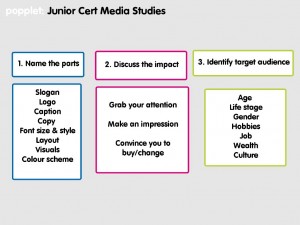I only remembered at lunch time yesterday that WBD was less than 24 hours away! So I was really impressed that it only took 20 minutes sitting on the floor outside my classroom with a couple of my Junior Certs & voilá – we planned a promo ; swore a solemn oath of secrecy; made a shopping list (blue tack, string, balloons, markers, bed sheet) & we were ready! Here’s the video of our escapades from earlier today:
[youtube_sc url=http://www.youtube.com/watch?v=QuzvONks7Q0]
This all tied in very neatly with what we’d been covering in class recently:
It also led to me discussing, on a completely impromptu basis (because of the buzz our event created) the basics of guerrilla marketing campaigns with several of my classes today. Here’s what we came up with as a guide to created a successful campaign:
RULES FOR GUERRILLA ADVERTISING CAMPAIGNS
- Secrecy – the element of surprise if crucial. Whatever you plan, it’s vital that no-one suspects anything.
- Unexpected event – try to do something new & original so people’s curiosity is piqued.
- Unexpected location – choose a public location where random madness is rare: a church, a train station, a hospital, a courthouse – but try not to get arrested!
- Rapid – keep it short! Those who are there must feel they were lucky enough to be in the right place at the right time. Those who hear about it afterwards must feel like they missed out!
- Planning – if you’re going to appear, do your thang & disappear, all in the space of 7 / 8 minutes, you’d better be sure everything’s ready in advance. As well as our shopping list, we agreed to leave the corridor untouched until after the 10.35 class began, then we transformed it so that when students emerged from neighbouring classrooms at 11.15, their environment had transformed utterly. Our lovely caretaker Mark also brought along a ladder & hung the balloons from the ceiling so we had no health & safety concerns to deal with!
- Message – there’s no point in having a memorable event, if nobody remembers what the event was promoting. Sticking the World Book Day vouchers – hundreds of them – on the walls made delivering our message pretty easy. Signs, posters, leaflets or props are a must.
- Respect – originally we discussed walking the corridors engrossed in a book & deliberately bumping into people, then wishing them a Happy World Book Day & handing them a voucher! However, we quickly decided against this. You don’t want people avoiding your event, you want them flocking towards it, but this must be a choice they want to make, so invading their personal space is a bad idea…
- Film It – the whole idea is to create a novel experience that people want to photograph / film and share on social media. This way you can reach thousands more, not just those who happened to be there! However, the video you create will probably be more professional & cover more camera angles than snippets of videos created by on-lookers so make it your priority to film from a few different angles. I was sorry afterwards we hadn’t gotten better reaction shots as people came in but without a zoom on our flip cams, there wasn’t a lot we could do! I blame our crappy equipment 😉 I was also sorry we hadn’t gotten an establishing shot of the corridor as it is normally so that you had a “before” and “after” effect. The better the video (content, originality, relevance to your life, and particularly if it’s funny!!!) the more likely it will be shared. The more it’s shared the more views it gets and the more successful your campaign has been.
As an aside, guerrilla marketing came up on the 2013 Junior Cert English Paper 1, in the media studies section.
Leaving Cert students were asked to write out the text to accompany an ad for a house as a QB in 2003 so there’s every chance something like this could come up in the exam. Plus, when you’re settled into college next year & you’ve got a part time job in promotions working for the Students Union Ents Crew, this might come in very useful indeed 😉







